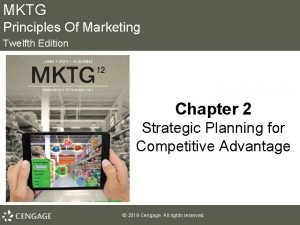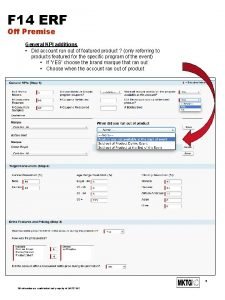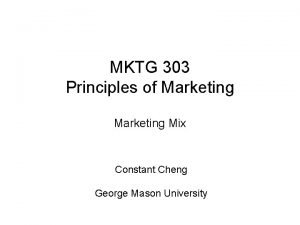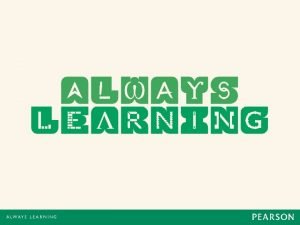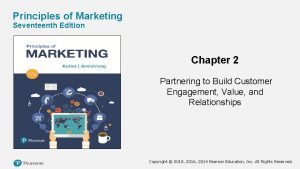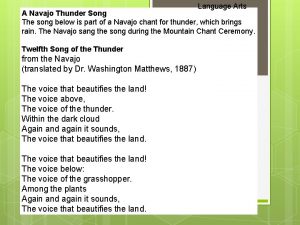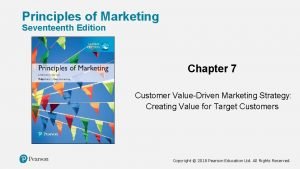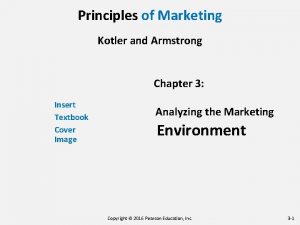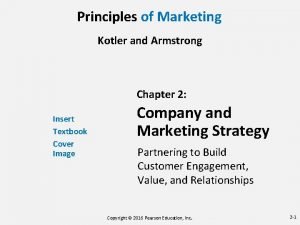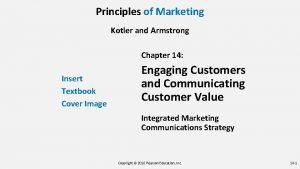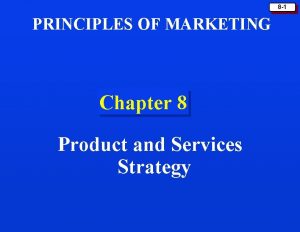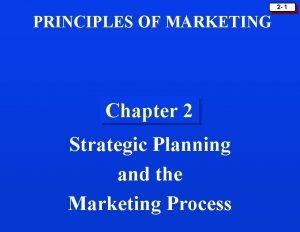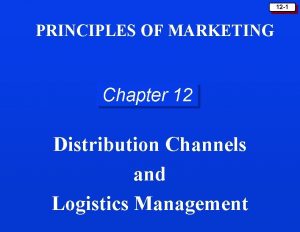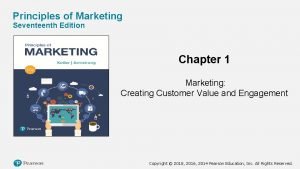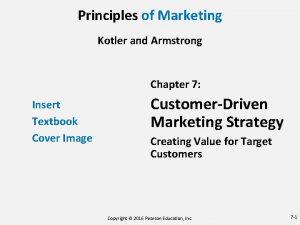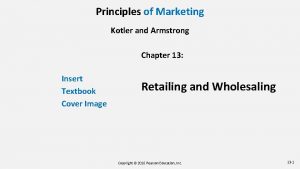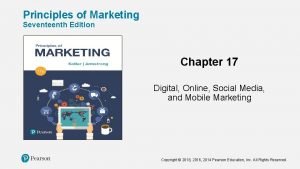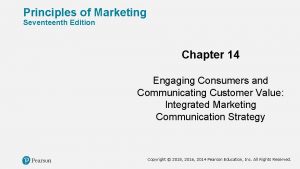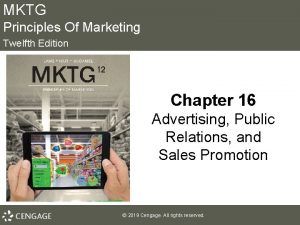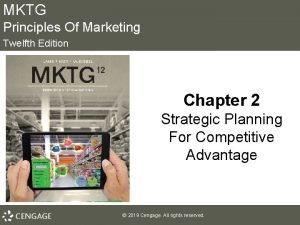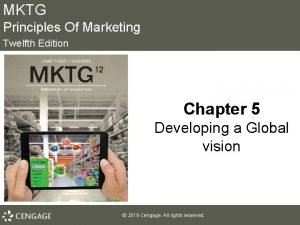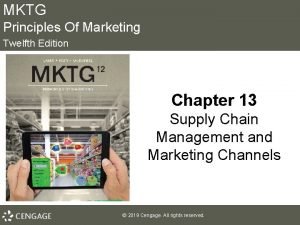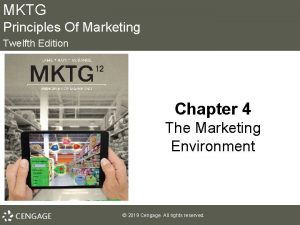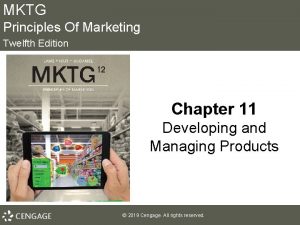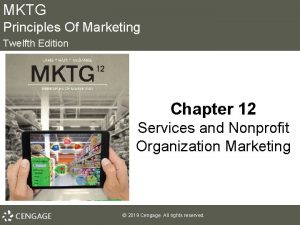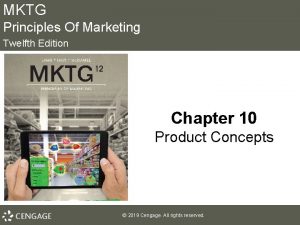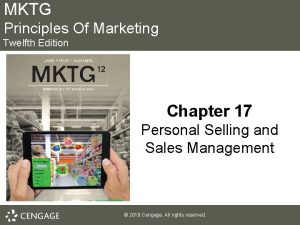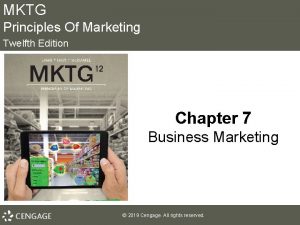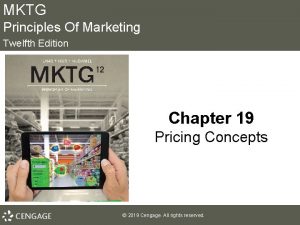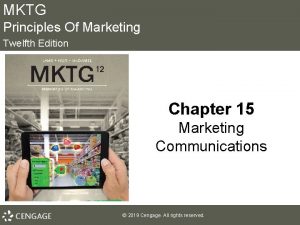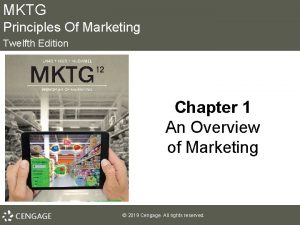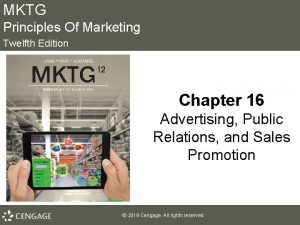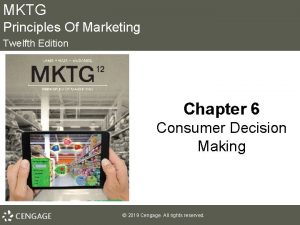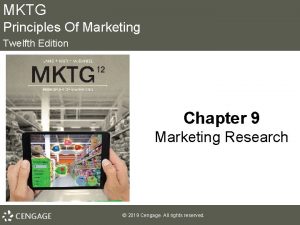MKTG Principles Of Marketing Twelfth Edition Chapter 8













































- Slides: 45

MKTG Principles Of Marketing Twelfth Edition Chapter 8 Segmenting and Targeting Markets © 2019 Cengage. All rights reserved.

Learning Outcomes (1 of 2) 8 -1 Describe the characteristics of markets and market segments 8 -2 Explain the importance of market segmentation 8 -3 Discuss the criteria for successful market segmentation 8 -4 Describe the bases commonly used to segment consumer markets 8 -5 Describe the bases for segmenting business markets 8 -6 List the steps involved in segmenting markets © 2019 Cengage. All rights reserved.

Learning Outcomes (2 of 2) 8 -7 Discuss alternative strategies for selecting target markets 8 -8 Explain how CRM can be used as a targeting tool 8 -9 Explain how and why firms implement positioning strategies and how product differentiation plays a role © 2019 Cengage. All rights reserved.

Learning Objective 1: Markets and Market Segments © 2019 Cengage. All rights reserved.

Market • Market – People or organizations with needs or wants and the ability and willingness to buy • Market segment – Subgroup of people or organizations sharing one or more characteristics that cause them to have similar product needs • Market segmentation – Process of dividing a market into meaningful, relatively similar, and identifiable segments or groups © 2019 Cengage. All rights reserved.

Learning Objective 2: The Importance of Market Segmentation © 2019 Cengage. All rights reserved.

Importance of Market Segmentation • Plays a key role in the marketing strategy of successful organizations • Powerful marketing tool • Helps marketers define customer needs and wants precisely • Helps decision makers define objectives and allocate resources more accurately © 2019 Cengage. All rights reserved.

Learning Objective 3: Criteria for Successful Segmentation © 2019 Cengage. All rights reserved.

Successful Segmentation • Produces market segments that meet: – Substantiality: Segment must be large enough to warrant developing and maintaining a special marketing mix. – Identifiability and measurability: Segment must be identifiable and its size measurable – Accessibility: Marketing mix must be reachable to members of targeted segments. – Responsiveness: Segment need not be treated separately unless it respond differently to a marketing mix © 2019 Cengage. All rights reserved.

Learning Objective 4: Bases for Segmenting Consumer Markets © 2019 Cengage. All rights reserved.

Bases for Segmentation • • • Geography Demography Psychographics Benefits sought Usage rate © 2019 Cengage. All rights reserved.

Geographic Segmentation • Segments markets by: – Region of a country or the world – Market size – Market density § Number of people within a unit of land – Climate § Impacts purchasing behavior © 2019 Cengage. All rights reserved.

Demographic Segmentation • • • Age Gender Income Ethnic background Family life cycle © 2019 Cengage. All rights reserved.

Age Segmentation • Segments markets by age into the following cohorts: – – – Tweens Teens Millennials Generation X War generation Great Depression generation © 2019 Cengage. All rights reserved.

Gender and Income Segmentation • Gender segmentation – Uses different strategies for men and women – Many marketers are going after the less-traditional market • Income segmentation – Income level influences consumers’ wants and determines their buying power § Retailers can appeal to low-income or high-income categories, or both © 2019 Cengage. All rights reserved.

Ethnic Segmentation • Some companies make products geared toward specific ethnic groups – To meet the needs and wants of expanding populations • Largest ethnic groups in the United States: – Hispanic Americans – African Americans – Asian Americans © 2019 Cengage. All rights reserved.

Family Life Cycle Segmentation • Consumption patterns among people of the same age and gender differ because they are in different stages of the family life cycle. • Series of stages are determined by a combination of age, marital status, and the presence or absence of children • The horizontal flow shows the traditional FLC. © 2019 Cengage. All rights reserved.

Exhibit 8. 1 Family Life Cycle © 2019 Cengage. All rights reserved.

Bases for Psychographic Segmentation • • Personality Motives Lifestyles Geodemographics © 2019 Cengage. All rights reserved.

Psychographic Segmentation • Psychographic segmentation is market segmentation on the basis of the following psychographic segmentation variables: – Personality : It reflects a person’s traits, attitudes, and habit. – Motives: Marketers of baby products and life insurance appeal to consumers’ emotional motives—namely, to care for their loved ones. – Lifestyles: Lifestyle segmentation divides people into groups according to the way they spend their time, the importance of the things around them, their beliefs, and socioeconomic characteristics such as income and education. – Geodemographics: Geodemographic segmentation clusters potential customers into neighborhood lifestyle categories. © 2019 Cengage. All rights reserved.

Benefit and Usage-Rate Segmentation • Benefit segmentation – Grouping customers into market segments according to the benefits they seek from the product • Usage-rate segmentation – Divides a market by the amount of product bought or consumed • 80/20 principle – Principle holding that 20 percent of all customers generate 80 percent of the demand © 2019 Cengage. All rights reserved.

Learning Objective 5: Bases for Segmenting Business Markets © 2019 Cengage. All rights reserved.

Segmentation Variables • The business market consists of four broad segments: producers, resellers, government, and institutions. • Further market segmentation offers just as many benefits to business marketers as it does to consumer product marketers. © 2019 Cengage. All rights reserved.

Company Characteristics • • • Geographic location Type of company Company size Product use Volume of purchase (heavy, moderate, light) is a commonly used basis for business segmentation © 2019 Cengage. All rights reserved.

Buying Processes • Satisficers – Business customers who place an order with the first familiar supplier to satisfy product and delivery requirements • Optimizers – Business customers who consider numerous suppliers, both familiar and unfamiliar, solicit bids, and study all proposals carefully before selecting one © 2019 Cengage. All rights reserved.

Learning Objective 6: Steps in Segmenting a Market © 2019 Cengage. All rights reserved.

Steps in Segmenting a Market • • • Selecting a market or product category for study Choosing a basis or bases for segmentation Selecting segmentation descriptors Profiling and analyzing segments Selecting markets Designing, implementing, and maintaining appropriate marketing mixes © 2019 Cengage. All rights reserved.

Learning Objective 7: Strategies for Selecting Target Markets © 2019 Cengage. All rights reserved.

Target Market • Group of people or organizations for which an organization designs, implements, and maintains a marketing mix – To meet the needs of that group, resulting in mutually satisfying exchanges • Strategies for selection – Undifferentiated targeting – Concentrated targeting – Multi segment targeting © 2019 Cengage. All rights reserved.

Target Marketing Strategies • Undifferentiated targeting strategy – Views the market as one big market with no individual segments and thus uses a single marketing mix • Concentrated targeting strategy – Selects one segment of a market for targeting marketing efforts • Multi segment targeting strategy – Chooses two or more well-defined market segments and develops a distinct marketing mix for each © 2019 Cengage. All rights reserved.

Exhibit 8. 2 Advantages and Disadvantages of Target Marketing Strategies © 2019 Cengage. All rights reserved.

Learning Objective 8: CRM as a Targeting Tool © 2019 Cengage. All rights reserved.

CRM • Companies that successfully implement CRM tend to customize the goods and services offered to their customers – Based on data generated through interactions between carefully defined groups of customers and the company • Can allow marketers to target customers with extremely relevant offerings © 2019 Cengage. All rights reserved.

Trends Leading to the Continuing Growth of CRM (1 of 3) • • Personalization Time savings Loyalty Technology © 2019 Cengage. All rights reserved.

Trends Leading to the Continuing Growth of CRM (2 of 3) • Personalization: One-size-fits-all marketing is no longer relevant. • Time savings: Direct and personal marketing efforts will continue to grow to meet the needs of consumers who no longer have the time to spend shopping and making purchase decisions. © 2019 Cengage. All rights reserved.

Trends Leading to the Continuing Growth of CRM (3 of 3) • Loyalty: Consumers will be loyal only to those companies and brands that have earned their loyalty and reinforced it at every purchase occasion. • Technology: Mass-media approaches will decline in importance as advances in market research and database technology allow marketers to collect detailed information on their customers. © 2019 Cengage. All rights reserved.

Learning Objective 9: Positioning © 2019 Cengage. All rights reserved.

Positioning, Perceptual Mapping, and Repositioning • Positioning – Influences potential customers’ overall perception of a brand, product line, or organization in general • Perceptual mapping – Means of displaying or graphing the location of products, brands, or groups of products in customers’ minds • Repositioning – Changing consumers' perceptions of a brand in relation to competing brands © 2019 Cengage. All rights reserved.

Positioning Bases (1 of 3) • • Attribute Price and quality Use or application Product user Product class Competitor Emotion © 2019 Cengage. All rights reserved.

Positioning Bases (2 of 3) • Attribute: A product is associated with an attribute, product feature, or customer benefit. • Price and quality: This positioning base may stress high price as a signal of quality or emphasize low price as an indication of value. • Use or application: Stressing uses or applications can be an effective means of positioning a product with buyers. • Product user: This positioning base focuses on a personality or type of user. © 2019 Cengage. All rights reserved.

Positioning Bases (3 of 3) • Product class: The objective here is to position the product as being associated with a particular category of products. • Competitor: Positioning against competitors is part of any positioning strategy. • Emotion: Positioning using emotion focuses on how the product makes customers feel. © 2019 Cengage. All rights reserved.

Exhibit 8. 3 Perceptual Map and Positioning Strategy for Saks Department Stores © 2019 Cengage. All rights reserved.

Key Terms (1 of 3) • • • Market segmentation Segmentation bases (variables) Geographic segmentation Demographic segmentation Family life cycle (FLC) Psychographic segmentation Geodemographic segmentation © 2019 Cengage. All rights reserved.

Key Terms (2 of 3) • • • Benefit segmentation Usage-rate segmentation 80/20 principle Satisficers Optimizers Target market Undifferentiated targeting strategy Concentrated targeting strategy Niche © 2019 Cengage. All rights reserved.

Key Terms (3 of 3) • • Multi segment targeting strategy Cannibalization Positioning Position Product differentiation Perceptual mapping Repositioning © 2019 Cengage. All rights reserved.
 Mktg 12 principles of marketing
Mktg 12 principles of marketing Principles of marketing chapter 1
Principles of marketing chapter 1 Mktg 12th edition
Mktg 12th edition Ricky w griffin management 12th edition pdf
Ricky w griffin management 12th edition pdf Bases for market segmentation
Bases for market segmentation Mktg emc
Mktg emc Sports entertainment products
Sports entertainment products Constant cheng
Constant cheng Mktg 10
Mktg 10 Principles of marketing fifth european edition
Principles of marketing fifth european edition Marketing kotler
Marketing kotler Principles of marketing seventeenth edition
Principles of marketing seventeenth edition Principles of marketing module 2
Principles of marketing module 2 Using mis 10th edition
Using mis 10th edition Mis
Mis Night structure
Night structure Twelfth night ppt
Twelfth night ppt I will drop in his way some obscure epistles of love
I will drop in his way some obscure epistles of love Structure of twelfth night
Structure of twelfth night Twelfth night dramatis personae
Twelfth night dramatis personae Twelfth night act 1 summary
Twelfth night act 1 summary Duke orsino
Duke orsino Themes in twelfth night
Themes in twelfth night Twelfth song of thunder figurative language
Twelfth song of thunder figurative language Twelfth night act 5
Twelfth night act 5 Orsino character traits
Orsino character traits A man lives on the twelfth floor of a tall building
A man lives on the twelfth floor of a tall building The twelfth of never
The twelfth of never Satire in twelfth night
Satire in twelfth night Deverell twelfth night
Deverell twelfth night Disappeared silent night
Disappeared silent night Shakespearean comedy vs tragedy
Shakespearean comedy vs tragedy Chapter 7 customer driven marketing strategy
Chapter 7 customer driven marketing strategy Principle of marketing chapter 5
Principle of marketing chapter 5 Principle of marketing chapter 3
Principle of marketing chapter 3 Principles of marketing pearson slides
Principles of marketing pearson slides Communication process
Communication process Product line decisions
Product line decisions Principles of marketing chapter 2
Principles of marketing chapter 2 Principles of marketing chapter 12
Principles of marketing chapter 12 Principle of marketing chapter 3
Principle of marketing chapter 3 Marketing: creating customer value and engagement
Marketing: creating customer value and engagement 7 cs of marketing by philip kotler
7 cs of marketing by philip kotler Principles of marketing chapter 13
Principles of marketing chapter 13 Principles of marketing chapter 17
Principles of marketing chapter 17 Principles of marketing chapter 14
Principles of marketing chapter 14
